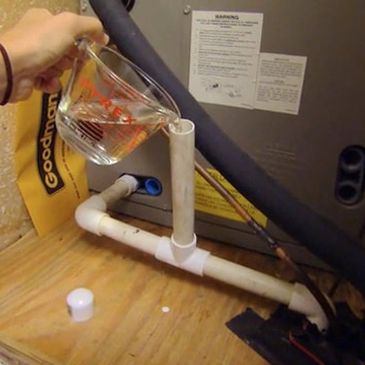Translate:
I've got a dirty what?! HVAC System Short Explanation

What is an air handler and compressor?
What is an air handler and compressor?
What is an air handler and compressor?
Those are actually used as blanket terms, but truly describe one part of the system. See the labeled chart above for a basic part breakdown. The Air Handler Unit is located somewhere inside the home, basement, garage. The Compressor Unit is located outside, usually at the side or back of the home.

What is the drain line?
What is an air handler and compressor?
What is an air handler and compressor?
There are typically 2 outflow lines, made of PVC pipe. One connects to the drain of the closest bathroom sink. The other exits the home through the side or back of the home. Usually the drain is over a window, so you can see water leaking out.

What about my ductwork?
What is an air handler and compressor?
What about my ductwork?
Now, you probably know what that is, but you don’t get in your attic much to check it out. So, here are a few diagrams of the more typical duct layouts. These can be found in an attic, basement, and in the walls and ceilings of your home.

How do I take care of my HVAC system?
If you’re anything like me, your HVAC system is an appliance you love, but know little about. Until I moved into my house and it suddenly became my responsibility to have it repaired, I was happily, even blissfully, unaware of what it did, beyond making my world lovely and comfortable - even in a Texas summer. However, I also have a need to understand what servicemen in my home are talking about. The info below helped me navigate my HVAC tech's explanation, and has made me a lot more aware of the small steps I can take to preserve the life of one of my favorite modern conveniences!
Recommendations
How often should I change my filter(s)?
How do I keep my condensation line(s) clean?
How do I keep my condensation line(s) clean?
We recommend Electrostatic filters! Electrostatic filters aren’t replaced, but washed off. These are a bit of an investment up front, but usually pay for themselves in the first 6 months. They are generally thought to be 10-35% more effective than disposable filters. Clean filters trap more dust, which keeps that dust from sticking to the ductwork, or worse, the HVAC unit itself. Dirty components are one of the leading causes of early HVAC failure, and failure to complete basic maintenance may void service or parts warranties!
How often you do this depends on your personal environment: pets, children, outdoor environment (dusty outside, construction in the neighborhood), and any allergies or sensitivities your family may have. At least once a month for 1” filters, and every 3-6 months for media or 4” filters.
How do I keep my condensation line(s) clean?
How do I keep my condensation line(s) clean?
How do I keep my condensation line(s) clean?
We recommend doing this every month!
Your condensation drain line (some homes have 2) is where the system drains all the condensation created by the chilled air. During the hottest summer months, your A/C can produce tens of gallons of water a day! The primary drain line typically connects to the drain on the closest bathroom sink. An additional line, called a secondary, often comes out of the side of the house, above a window, or in some other visible spot. Simply pouring a cup of white vinegar down the main drain line can help keep both pipes clean, preventing mildew growth. Clogged lines eventually flood the drain pan, and can eventually flood the attic. 1 cup of white vinegar once a month takes care of this problem. Some places or people may suggest bleach, but as this is caustic, it may actually cause long-term problems with the piping, as well as being toxic to plants and animals, if ingested.
How often should I get my ducts cleaned?
How often should I get my ducts cleaned?
How often should I get my ducts cleaned?
We recommend 18-24 for maintenance cleans.
These include: Vacuuming out each individual air duct and return with high powered, negative pressure vacuum to remove dust, debris, hair, and dirt.
Maintenance clean achieve a few things, including: helping to reduce the amount of dusting your home needs, reducing airborne allergines such as dust, pollen, and pet dander. Equally important, it helps you ensure you are taking every step to prolong the lifetime and efficiency of your HVAC system.
When is a deep clean necessary?
How often should I get my ducts cleaned?
How often should I get my ducts cleaned?
We recommend every 4-6 years, depending on your personal environment.
Several deep cleaning services that can be done separately or to-
gether which include: Sanitization with anti-fungal and anti-bacterial solutions
mold Treatment that eradicates fungus within the air ducts/unit,
and rotor brush for solidified dirt and debris.
Air ducts, especially in climates where A/C is used, can create the perfect breeding ground for mold. They are dark, cool spaces that are often surrounded by warm air. The contrast between warm and cold air creates condensation on the inside of the ducts, which dust, dirt, and hair sticks to. This mud is full of mold food, so the furry stuff settles in and spreads. Just like outdoor mold spores, which sometimes exacerbate allergy symptoms, these can also affect people with sensitivities or respiratory illnesses.